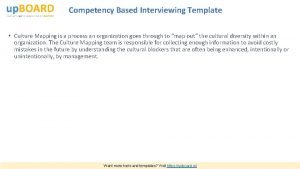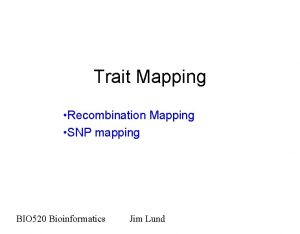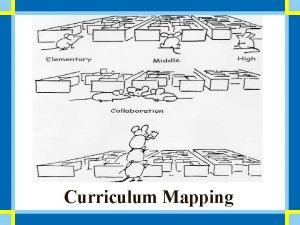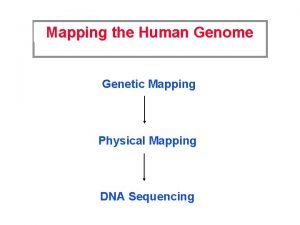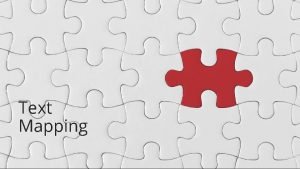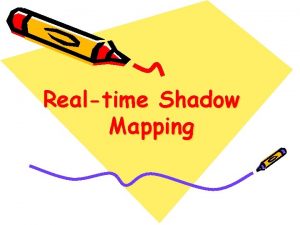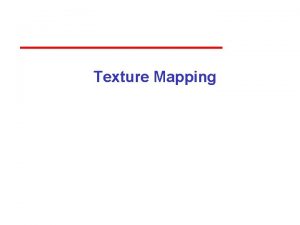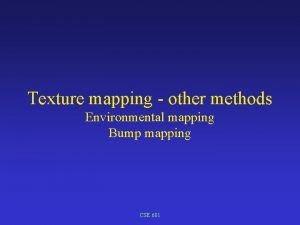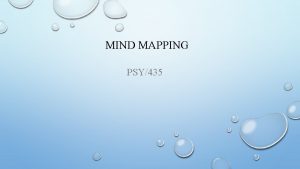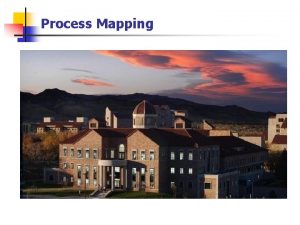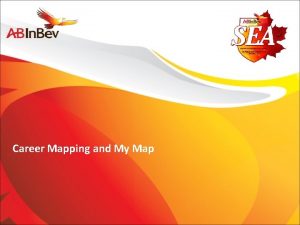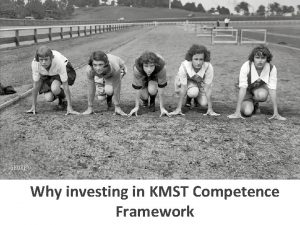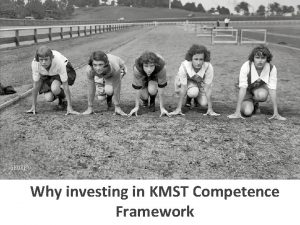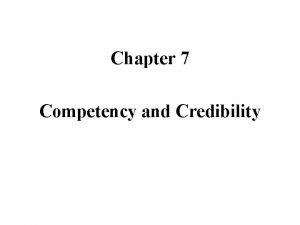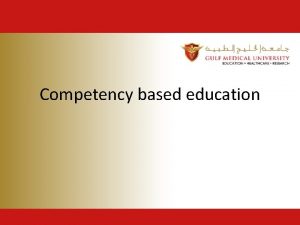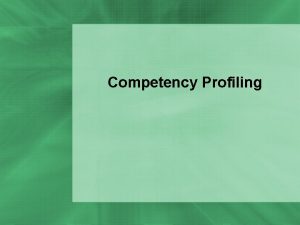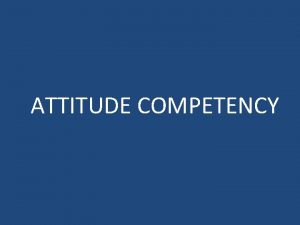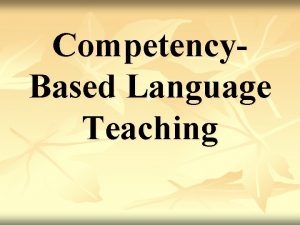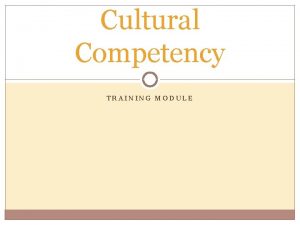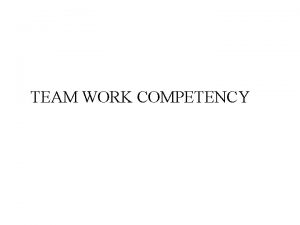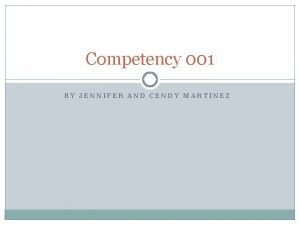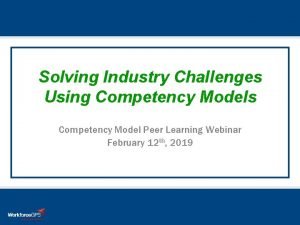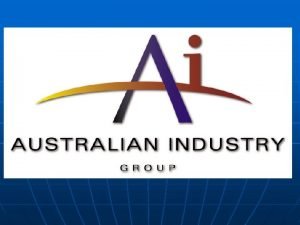Lecture 31 Competency Mapping Competency Mapping Why competency


































- Slides: 34

Lecture 31

Competency Mapping

Competency Mapping Why competency mapping ? n. Cost of manpower n. Cost of incompetence n. Planned competency development n. Employee engagement n. ISO/TS requirement

Competency-based Management practices Acts as a basis for. . . n Performance Management n Learning & Development n New Assignment / Project allocation n Job Rotation n Promotion n Compensation n Career Development n Selection

What is a competency ? Any underlying characteristic of an individual, an operative thought or behaviour, causally related to superior performance on the job. • Observable • Measurable • Consistent Reflected in a pattern of actions (skills), thoughts (knowledge) and feelings (attitudes) in the individual.

History of Competencies Pioneers : 1) David Mc. Clelland, the famous Harvard Psychologist: Article in 1973 in American Psychologist highlighting the importance of job related competencies over IQ & academic scores 2) Douglas Brey and Associates at AT & T gave the concept of assessment centres for predicting on the job success These two researches popularised the competency concept. Later Mc. Ber, a consulting firm founded by David Mc. Clelland & David Berlew specialised in mapping the competencies and use of behaviour event Interviewing (BEI) Main trigger > the limitations of Performance Appraisal

Competency Ice-berg Model Core Personality: Most difficult to develop “Intent” Skill Self-image Visible Skill Knowledge Trait, Motive Attitudes, Values Hidden Attitudes, values Self-image Trait Motive The Iceberg Model Knowledge Surface: Most easily developed

Competency Ice-berg (contd. ) Knowledge Content knowledge/information in field of work, - from education and experience Skill Ability to do something well; most easily trained on - e. g. technical skills to use knowledge Social Role How people perceive me; how I present myself - e. g. a loyal employee, a leader Self-Concept How people see/view themselves; identity; worth - e. g. an expert, a teacher Traits Habitual / enduring characteristics - e. g. flexibility, self-control, good listener Motives Unconscious drives that predict behavior - e. g. achievement, influence/power, affiliation

Generic & functional competencies Generic competencies are managerial and cognitive competencies required in small or large measure across functions. E. g. analytical skills, customer focus, etc. Functional competencies are those which are required in small or large measure within specific functions. E. g. knowledge of products, labor laws, etc.

Threshold & Differentiating Competencies Threshold competencies are the characteristics which any job holder needs to have to do the job effectively – but do not distinguish the average from superior performer. E. g. language skills, computer skills etc. Differentiating competencies are those characteristics which superior performers have but are not present in the average performers. E. g. empathy, ability to scan the environment for opportunities, etc.

Competency Dictionary Documented combination of competencies and their description in a language specific to an organisation, its functions and levels. It often also describes each competency in behavioral terms at different levels of proficiency, like Basic, Advanced and Expert

ACPL- Generic Competencies common to all managers COMPETENCY 1. Communication DESCRIPTION Written, verbal, Presentation, Listening, Negotiation, Non-verbal, Body Language, Listening to the unsaid, with holding giving concepts, concerns in communication, Put forth own proposal / point of view so that it do not gets turned down. 2. Analytical Ability to analyze the situation in the context of business. 3. Decision Making Ability to take good decision considering the alternatives.

ACPL- Generic Competencies COMPETENCY DESCRIPTION 4. Creative Thinking Out of the box thinking/ability to challenge/ (Not Innovation) appreciate status quo being challenged. 5. Customer focus Focus on internal as well as external customers with a view to meet their changing expectations (By setting benchmarks). 6. Emotional Intelligence More team work ‘not being a passenger, dependable, inter-personal skills through selfawareness of strengths/weakness, awareness of environment, social circles, impulse control and perseverance.

ACPL- Generic Competencies COMPETENCY 7. Achievement Motivation (Applied Learning) 8. Conceptual Ability (for strategic thinking) 9. Business Literacy DESCRIPTION Sets his own benchmark, Self-driven, Assertiveness, Self-motivated. Ability to think abstractly as an aid formulation of strategy. Cost consciousness, understanding P&L / payback etc. , Keeping holistic business picture in mind. 10. Systems orientation Appreciation of Quality systems/GMP/ISO, Management systems & Operative systems/ ability to take corrective action rather than disposition. 11. Planning Business planning and planning of all the resources.

ACPL- Functional Competencies • Role: General Manager - Manufacturing 1. Sound Engineering concepts. 2. Sound understanding of Quality Management Systems. • Role: General Manager - Commercial 1. Business acumen 2. Customer relationship management (CRM) 3. Understand Navigate statutory requirements

ACPL- Functional Competencies • Role: General Manager - Operations 1. Sound Engineering concepts. 2. Sound understanding of Quality Management Systems. 3. Versatility in handling a range of functions. • Role: Senior Manager - Personnel & Administration 1. Sound knowledge of HRD concepts / tools and Labor laws. 2. Union (IR) negotiation skills. 3. Group process facilitation skills.

ACPL- Functional Competencies • Role: DGM - PFD & Projects 1. Sound Engineering concepts & project management skills. 2. Management of logistics. 3. Sound understanding of Quality Management Systems. • Role: Manager - Quality Assurance 1. Sound knowledge of Quality Management Systems. 2. Sound Knowledge of statutory and regulatory requirements. 3. Sound Pharma Concepts.

Competency fundas n n n The ultimate aim of the exercise is performance – the individual’s & the organization’s All organization members must have a reasonable proficiency in a few key competencies determined by its business and strategy A majority of key competencies are generic in nature, with a few knowledge competencies specific to the nature of business A clear understanding of every member’s job profile is crucial to competency mapping Stake holder expectations define a job and its competency requirements Competencies are reflected in the proficiency of performing the key activities of a job

Competency Mapping

What is Competency Mapping? • The process of identification of the competencies required to perform successfully a given job or role or a set of tasks at a given point in time It consist of breaking a given role or job into its constituent tasks or activities and identifying the competencies needed to perform the same successfully •

Competency Mapping Methods • The Behavioral Event Interview (BEI) • Expert panels • Focus groups • Surveys • Psychometric tests

Competency Assessment

The Behavioral Event Interview It is a structured interview to identify specific behaviors which produce successful results. It identifies and compares thoughts, feelings, behaviors and outcomes reported by outstanding performers with those reported by average performers and is a tool for identifying differentiating competencies.

Competency Assessment Evaluation of the extent to which a given individual or a set of individuals possess these competencies required by a given role or set of roles or levels of jobs.

Competency Assessment Methods • Assessment Centers • 360 degrees feedback • Psychometric tests

Origin of Assessment Centres • First used by German military psychologists during World War II to select officers • The War Office Selection Board of the British Army during the 1940 s and US office of strategic services used the method to select spies • After WW II many military psychologists and officers joined private companies, where they started small scale assessment centres • In 1956, AT & T was the first to use the method on a large scale to test managerial potential

Assessment Centers • Use multiple methods and multiple assessors to enhance objectivity. • Use psychometric tests, stimulation exercises, presentations, in basket exercises, interviews, role plays, group discussions etc. • Methods used depend on nature of competencies • Competencies can be identified by experts, HR specialists, job analysts, psychologists etc. . in consultation with line managers, current and past role holders, supervisors, internal customers and subordinates.

Job Description & Competencies GOALS KEY RESPONSIBILITIES COMPETENCIES KEY ACTIVITIES

Competency Mapping Sheet

Gap Interpretation in terms of Developmental perspective RP - AP ACTION TO BE TAKEN • -ve Surplus • 1 Kaizen (Continuous improvement) • 2 Planned effort/ improvement / training • 3 or more Major development effort required (possibility of job change if the competency is critical)


Stages in installing Competency based Management 1. 2. 3. 4. 5. Develop a competency dictionary Map the competency requirements of jobs Assess competencies of job holders Plan action to deal with competency gaps Implement action in a sustained way

Dr. T V R says … “ Competency mapping is essentially an in-house job. Consultants can at best give the methodology and train up the line managers and HR staff. Consultants cannot do competency mapping all by themselves because no consultant can ever have all the knowledge required to identify the technologies, managerial, human relations and other conceptual knowledge, attitudes and skills required for all jobs in a firm. Where consultant are extensively relied upon the data generated are likely to enrich the consultant much more than the firm. The lower the consultant’s involvement, more the work needs to done internally and higher the intellectual capital generation and retention within the organisation. ”

 Pictures
Pictures 01:640:244 lecture notes - lecture 15: plat, idah, farad
01:640:244 lecture notes - lecture 15: plat, idah, farad Competency mapping template
Competency mapping template Dont ask why why why
Dont ask why why why Memory parameters
Memory parameters Forward mapping vs backward mapping
Forward mapping vs backward mapping Terjemahan
Terjemahan Why-why analysis
Why-why analysis Wh tongue twister
Wh tongue twister Does the table represent a function why or why not
Does the table represent a function why or why not Does the table represent a function why or why not
Does the table represent a function why or why not Why or why not
Why or why not Metode analisa masalah
Metode analisa masalah Project procurement management lecture notes
Project procurement management lecture notes Lecture about sport
Lecture about sport Lecture on healthy lifestyle
Lecture on healthy lifestyle Meaning of this
Meaning of this Life lecture meaning
Life lecture meaning Randy pausch the last lecture summary
Randy pausch the last lecture summary Tensorflow lecture
Tensorflow lecture Theology proper lecture notes
Theology proper lecture notes Strategic management lecture
Strategic management lecture Geology lecture series
Geology lecture series Social psychology lecture
Social psychology lecture In text citation for a lecture
In text citation for a lecture Advantages of government accounting
Advantages of government accounting Software project management notes
Software project management notes Eurocode reinforcement detailing
Eurocode reinforcement detailing Magnetism
Magnetism Physics 111 lecture notes
Physics 111 lecture notes Physics 101 lecture notes pdf
Physics 101 lecture notes pdf Physical science lecture notes
Physical science lecture notes Power system dynamics and stability lecture notes
Power system dynamics and stability lecture notes Natural language processing nlp - theory lecture
Natural language processing nlp - theory lecture Microbial physiology lecture notes
Microbial physiology lecture notes


